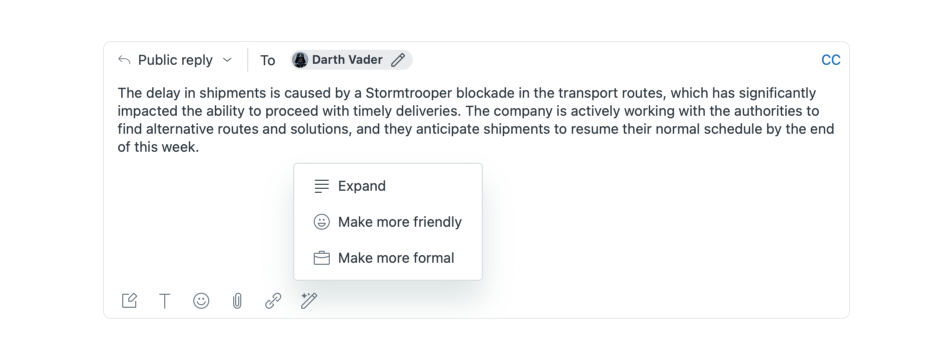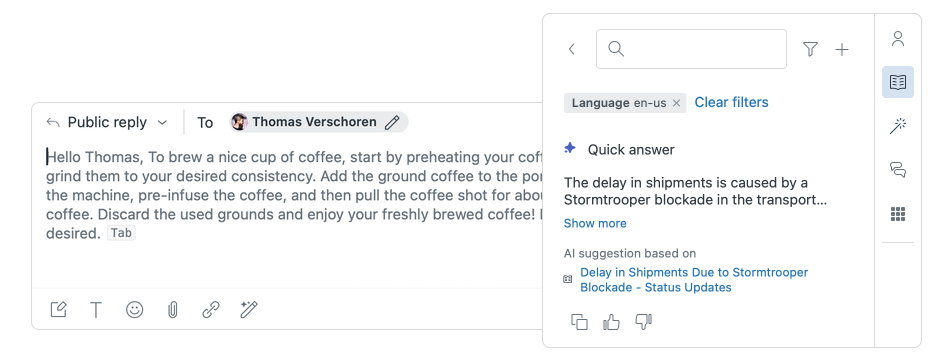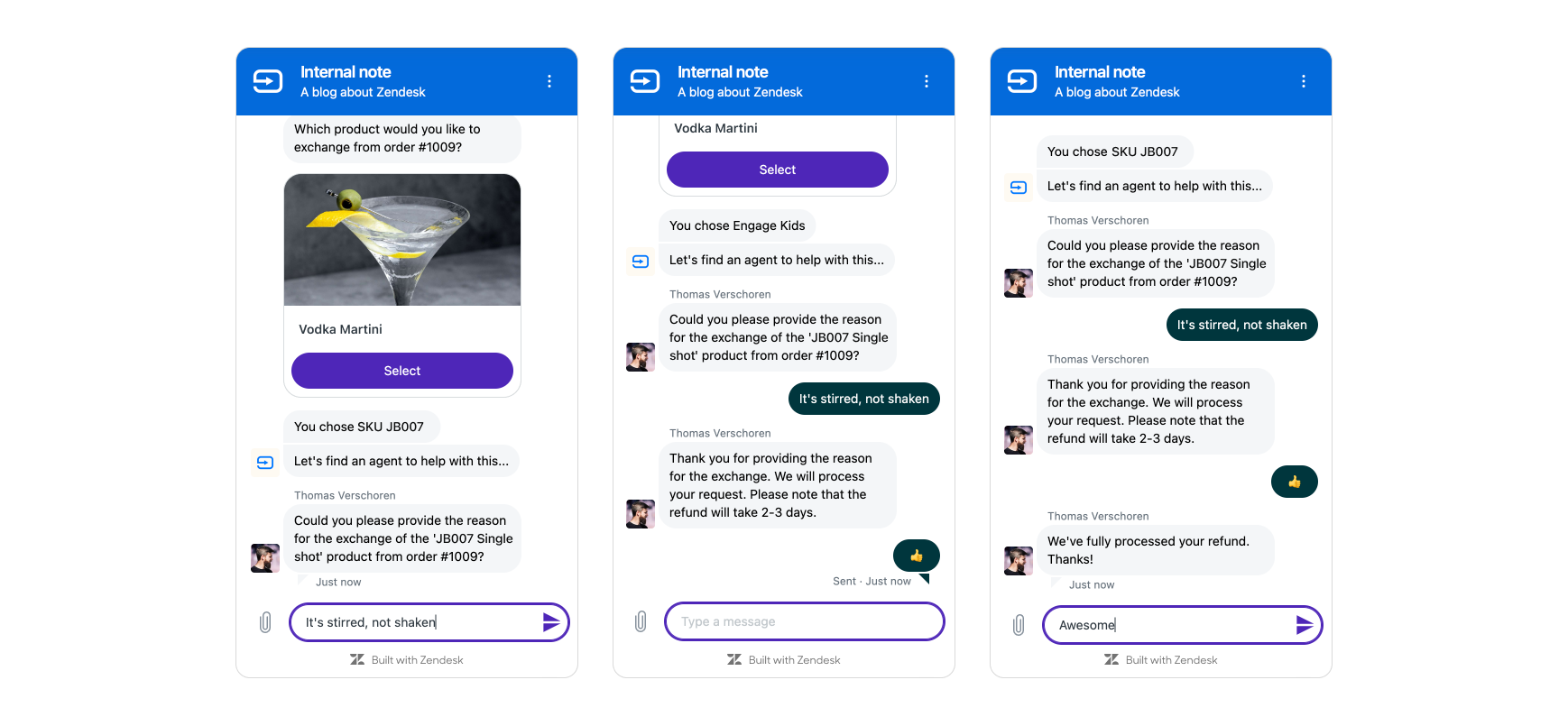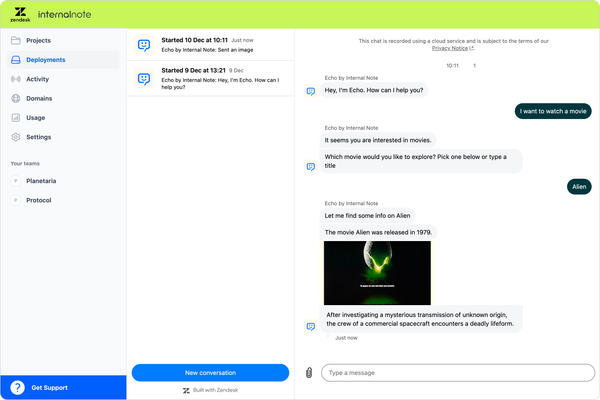
Preview of the new Agent Copilot for Zendesk
A few months after its announcement at Relate, I finally had to chance to explore the new AI Co-pilot for agents in Zendesk. This article will explore what the Co-pilot can do, how it works and some initial impressions.
At Relate 2024 Zendesk presented their latest Zendesk AI features, turning Zendesk into a Complete Solution for the AI era.
They focused on the customer, the agent, and the company as a whole within their releases.

Customers now interact with an AI Agent first. This bot offers self service with generated responses pulled from a help center, offers flows to route the customer to a solution, or used hybrid flows powered by integrations to automate processes for the Agent.
Human agents are still part of the flow. Even though AI can handle a lot of inquiries, agents are still there to help customer with the complex, the personal and the, by lack of a better name, human touch when handling tickets. Zendesk’s intelligent triage with its summary and intent features, and the contextual features like the knowledge panel, macro and suggestions or similar tickets all assist in finding the information quickly to solve a ticket.
And thirdly a company can get insights in their efforts and team with Zendesk’s new WEM solution combining both Quality assessment, workforce management and the traditional Explore reporting.
Omnichannel Automation
Most, if not all, of the features announced at Relate are now available within Zendesk as released products or as early access programs to subscribe too.
One announcement of the event however still remains partially under wraps, and that is their new Copilot feature.
When Zendesk AI launched in 2023 it came with some additions to the comment field in Agent Workspace. Agents could expand an existing comment and turn a short reply into a longer, more nuanced and personal reply with context like the customers’ name added to the comment.
And Tone-shift takes an existing comment and turns it into a more friendly and casual, or professional reply.

Earlier this year Zendesk added two new features to assist agents with replying. Suggested Replies offer a prewritten reply which can be accepted by agents by pressing the tab key. It pulls data from the knowledge base, previous tickets and macros and learns over time.
The new Quick answer for the Knowledge base offers prewritten replies in the context panel pulled from your Help Center articles, which can be added to the ticket with the click of a button

The new Zendesk Copilot takes the existing reply features in Zendesk and turns them to 11.
Ticket automation
Traditionally there's two types of tickets we see in a ticketing tool.
One kind are those tickets that can be solved by a help center article. The article nicely explains the steps to take to resolve the tickets and the actionability lies on the side of the end-user requesting the ticket. The agents' role lies in making sure the customers sees the right Help Center article and guide them through the steps.
The other kind of tickets are those where the actions lie on the side of the agent or company. Executing a refund, updating an order, looking up a status or handling exceptions are all tickets that an agent needs to handle, and the customers is just awaiting a resolution or update.
Where the first kind of tickets was originally handled by the agent dutifully replying with content pulled from your Help Center, macros or internal knowledge base. But, the more powerful AI Agents became, the more of these kind of questions are resolved by chatbots and auto-replies via email (the old Answer Bot).
What’s left for agents are those tickets that are actionable and often require a process or a lot more information.
An Example
Let’s take a refund flow for a product for example. Even though the chatbot can explain the customer when they’re eligible for a refund, or ask for information like order numbers or return reasons, it’s the agent that needs to approve and execute the actual refund in your webshop.
While AI Agents over chat can collect all the required information, the conversation still ends up with an agent who needs to act upon it.
Similarly, when a customers emails your team with “I want a refund now!”, your agents are required to reply to the email and ask for all that information. And we can only hope the customer replies with all the data in one reply. Which always happens. Right?
When we finally have that information, our agent takes that order number, product and reason and goes to the CRM executes that refund, updates the ticket, lets the customer know all is well, and finally solves the ticket.
We can do better
Assuming we already leverage a good AI Agent, big parts of the above flow can be optimized already. But repeat the above scenario across dozens of tickets and we can quickly discover were agents loose time, or get numbed by the same actions all the time.
- They need to learn all processes in your company
- They need identify the intent and process (refund)
- They need to read the conversation and ticket fields to see if we have all the required information (order number, product, reason,...)
- They need to validate that everything is correct
- They need to execute a refund
- They need to inform the customer.
This is where the Zendesk AI Copilot comes in.
Copilot
Copilot takes the above steps and automates them for the Agent. It is there to assist the agent throughout the entire process.
- It is based on your processes
- It can identify the intent and link it to the right procedure
- It can ask for the right information to complete the task
- It can validate that everything is correct
- It can execute actions to be taken
- It can propose a reply to the agent to inform the customer.
Opposite to for example the GitHub Copilot we see in Visual Studio Code, or Intercom's Copilot we don't need to ask the Copilot how to do something, but Zendesk's Copilot will actually take over from the Agent and just do the right thing. The agent, similar to a real pilot is there to make sure the Copilot does the right thing, and take over if things escalate or if a more personal touch is needed.
How does it work.
Setting up Copilot starts with writing down a procedure to be followed for a certain Intent. Setting it up does to require any code or flow-building. If you can explain your process in logical steps, you can set up Copilot.
If Copilot detect an intent for a ticket, it will then follow the linked procedure. It will offer the agent replies they should send to the customer in order to resolve the ticket or if actions should be taken, it'll show buttons to the agent to do so.
We can define our procedure as follows:
Exchange a product
To exchange a product we need to know:
- the order number
- the product name
- the return reason
Once we know this, we need to check in Shopify if this is a valid combination. If so we can refund the product to the customer.
We need to let the customer know this can take 2-3 days to be processed.
You’ll immediately notice that this is just regular text. I’ve written down the process in plain English without any fancy code or markup.
And this is one of the most awesome parts of Copilot from an admin perspective. You can define a process as a company, write it in a Google Doc and give that to your Zendesk Admin or CX Team Lead. They can copy the process, paste it Copilot as a procedure and that's it. The AI model underlying Copilot reads those procedures, and trains itself to take care of this process.
In this EAP I could only test retail flows but even there, the easy of use and wins in efficiency already showed. For example, when a customer mentioned an order number, not only does Copilot pickup that number, it also verified in Shopify if the user and the order number match:

An email flow with Copilot
Let's make this real and go through an actual flow.
Let's say a customer emails customer care because they want to exchange or refund product.

When our agent opens the ticket in the Agent Workspace they’ll notice that the comment fields has been replaced with a new Copilot mode.
The Copilot read our customers' email, and offers a reply to collect the missing information. The Agent can either accept and submit the reply
If our customer then replies with a product and a reason, the Copilot once again offers a reply. This time confirming information, and politely asking the customer for the order number.

When we’ve finally collected all required metadata, we see a new button appear in Copilot. This time the system offers to cancel the items and the agent can execute the refund with the click of a button, and reply to the customer with some additional information on what happens now.

Copilot then offers to solve the ticket.

A chatbot flow with Agent Copilot
Let’s take this same flow, but now our customer contacts us over Messaging and an AI Agent intercepts the conversation.
The first steps of the flow are handled by our bot. It shows a list of available orders, and then shows the items within an order to our customer.

At the end of the flow we pass the conversation to our agents. When the ticket arrives in Agent Workspace we already get a lot of context. The bot collected the order number and product already, so this time Copilot offers a reply asking for the return reason only.

And similarly to the example earlier, Copilot wraps up by offering a refund button, and we can close our ticket.
For the customer, this interaction feels like a regular interaction with a real agent:

Efficiency Gains
The efficiency gains enabled by Copilot are immediately visible. For every procedure defined for Copilot, our agent only needs to verify the proposed actions are correct, and they can submit or approve the next steps for the customer.
Only in scenarios where the solution is wrong, or where Copilot doesn’t know how to handle the ticket, will agents actually need to jump in and use the existing AI tools and their own skills to resolve the ticket.

Copilot doesn’t require every procedure to be written down for it to work. Similar to generative replies for the Zendesk Bot and its custom answers, if no procedure is defined, Copilot will fall back to replies generated from macros and your knowledge base, similar to the suggested reply feature available today.
I was also surprised by how nicely it could context switch. In one of my tests I asked the Copilot for washing instructions for a jersey and I had imported Help Center articles for denim, cotton, polyester. The Copilot asked me which fabric I had and I replied with “denim”.
While I saw the reply being generated as an agent (which takes less than a second), I quickly had my demo user reply again with “cotton”.
Copilot immediately started generating a new response and gave instructions for both fabrics, prefaced with a short “in case you need both..”.
Conclusion
For now, Copilot is in private beta and isn’t available yet for everyone to try. It only works in English, and its intents are limited to retail environments. And actions can only be executed in Shopify for now.
But ignoring these limitations for now, if we look at the feature for what it can be it’s clear that this will be a game changer for both agents and Zendesk admins.
Once this becomes broadly available agents this will unlock some great benefits from the get go. The obvious one is the fact that agent will need to write less and that team leads can be sure processes are followed.
This means agent can focus even more on the exceptions and really dive deep into the complex tickets that require their real attention.
Similar, when onboarding new people to the team it’ll become way easier to get them up to speed. Now it requires learning complex processes and taking in all the data needed and steps taken to resolve a ticket. With Copilot the system will guide the new agent through their first refund ticket and while reading along with the responses the new agent can learn those processes on the go.
There’s a few things I wonder about though. If you need to take care of hundreds of Refund ticket a day, accepting those replies will become a shore after a while. Luckily Zendesk already announced at Relate that the end goal of Copilot will be a way for Admins to set a threshold. And for all replies where that threshold is met, Copilot will autonomously reply, leaving only the edge cases for Agents to approve.
The relationship between Copilot and AI Agents is also tricky. Where AI Agents stop, Copilots begin. If your process requires human approval for refunds, the AI Agent can only do as much and identify the user, tag the intent and collect metadata. It’s the Copilot that then takes over, with final approval by the Agent.
I kinda hope we can someday define our procedure in Copilot and have an AI Agent feed from that as well. If our process requires an Order number and reason for a refund, there should be no reason we need to manually built that Answer flow in the bot, when Copilot can generate that process automatically.
Putting aside future wishes, I was really surprised by how solid the Copilot worked. The example flows I showed you above were built in a matter of minutes without resorting to documentation and worked immediately.
Really curious how this will evolve in the next few months and years!





